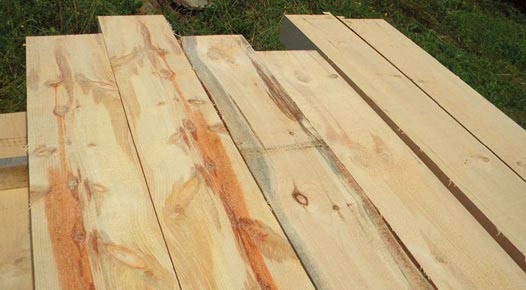We milled a bunch of beautiful-looking white pine logs the other day and found that many boards had red rot in them. Can you tell me more about red rot?
Red rot is the local name for a common wood decay disease. It is a trunk rot. Variously known as red ring rot, red heart, heart rot, ring scale, and pocket rot, this disease is caused by a fungus (Phellinus pini) with a wide geographic distribution. It exists throughout the northern temperate zone, it infects more than a hundred species of conifers worldwide, and it causes more wood decay in living pine trees than any other fungus.
While there are certainly many kinds of decay that can attack softwoods (and some can even cause reddish coloring), red rot is by far the most common in our region. As too many of us have learned the hard way, infected trees become structurally unsound and suffer significant loss of useable wood. Interestingly, it only infects living wood; it does not decay wood products such as poles, posts, and structural timbers.
Typically, red rot begins its invasion of a tree when its spores attach to a dead branch stub or a wound. It takes a very long time for decay to follow. Evidently, this is especially true when decay develops in the heartwood of trees whose leader shoots were killed many years before by the white pine weevil. The fungus may be present in recently dead (or pruned) branch stubs or weevil-killed leaders, but actual wood decay does not begin until the wood has grown over the branch scar or dead leader, usually several years later.
In pine, early stage red rot appears as a pinkish or red stain, often forming concentric rings in cross section. As decay progresses, thread-like fibers of the fungus invade wood cells and small, white, lens-shaped pockets of rot develop. In advanced stages, the wood becomes soft and lighter-colored as the fungus selectively consumes lignin, the chief structural constituent of wood cells. Over time, columns of decay develop within trunks, often extending 30 feet or more, rendering multiple log sections useless for lumber and predisposing the trunk to breakage. Decay normally occurs in the trunk, but butt rot is also common, and the rot sometimes even extends into major roots.
Damage from red rot is much greater in older pine trees, but not necessarily due to increased susceptibility. Rather, the greater prevalence in older trees is thought to result simply from longer exposure and more time for the decay to develop. Slowgrowing trees also tend to exhibit more decay. This is because there is less new wood produced each year, and it takes longer for wounds to be covered, thus increasing the tree’s exposure to infection. Then again, fast-growing pines are not immune. Indeed, many large, fast-growing pines have large crowns resulting from past weevil damage, which is known to increase the likelihood of red rot infection.
It is not hard to find a forester, logger, or landowner who has been gravely disappointed by rotten wood they found in logs cut from beautiful-looking pine trees. That is the hard truth about red rot. Despite the massive internal damage it causes – degrading large sawtimber trees to pulp or cull – the presence of red rot inside a tree is often very hard, or even impossible, to detect from the outside.
Still, we try. We look for swollen knots where branches were shed or pruned years before. We look for resin flow from the knots. And we look for signs of the fungus itself: brown or blackened spore-producing protrusions at branch bases, stubs, and knots, or the brownish perennial conks of the causal fungus, which usually develop at branch stubs and vary from thin and bracket-shaped to thick and hoof-like. All of these indicators suggest there is rot within.
In addition, most foresters try to develop a sense of local conditions under which red rot is most likely to occur, so that they can plan and manage accordingly and minimize disappointment. Conventional thinking holds that it is less common on good pine-growing ground and more common on poor sites.
But the reality is that red rot occurs across many sites, stocking conditions, and management strategies, and it’s probably folly to think otherwise. That’s because, hard as it is to accept, red rot is not merely a frustration to wood growers, sellers, and users. It is caused by a native organism with a rightful place in healthy forests, and as such it plays important – if unheralded and nonmonetized – roles in normal forest function. Don’t tell a cavity-nesting bird or mammal that red rot is bad, because while it is a major irritant to us, their lives depend on rotten trees – the bigger the better.


